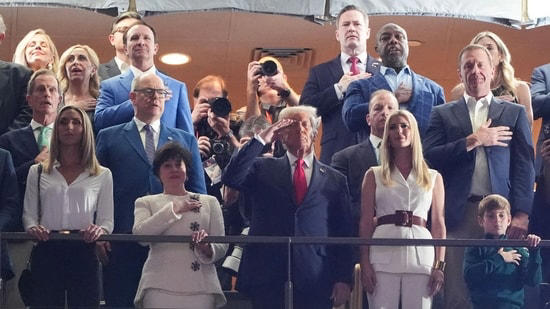Super Bowl viewers continue to express mixed reactions following the moment when the camera briefly focused on Donald Trump during the national anthem
Super Bowl LIX at the Caesars Superdome in New Orleans made history when President Donald Trump became the first sitting U.S. president to attend the prestigious event. His presence, however, sparked varied reactions, particularly during the national anthem, prompting a wave of debate among fans and social media users. While some spectators appeared to enthusiastically welcome Trump, others questioned whether the response was genuinely supportive or a subtle form of disapproval.
A Historic Moment and the Anthem
As the Kansas City Chiefs and the Philadelphia Eagles prepared for a high-stakes showdown on February 9, 2025, anticipation for the game was heightened by more than just the on-field drama. The fact that President Trump was in attendance added a historic dimension to the Super Bowl. His appearance made waves, becoming a focal point not only for sports fans but also for political observers.
During the pre-game festivities, acclaimed musician Jon Batiste performed a powerful rendition of the national anthem. As his performance resonated through the stadium, cameras captured a brief moment where President Trump was shown on the big screen, sitting among the crowd. While many viewers noted what appeared to be an enthusiastic reception for the President, others took to social media to question whether the applause was truly as overwhelming as it seemed. The incident quickly sparked a conversation, with differing interpretations of the crowd’s reaction.
The Mixed Response on Social Media
In the aftermath of the moment, social media platforms erupted with mixed reactions. Some viewers speculated that the cheers shown on camera might have been accompanied by boos, with one Twitter user humorously remarking, “Y’all didn’t boo at Donald Trump loud enough,” suggesting that part of the audience might not have been as welcoming as it appeared. Others expressed frustration with the camera angle, with one user stating, “That was pretty s**tty to show Trump during Jon Batiste singing the National Anthem; it forced me and half of America to boo.” These comments illustrate the divided nature of the audience’s response, with some interpreting the moment as a genuine show of support and others seeing it as an expression of dissent.
Adding to the ambiguity, many users were unsure whether the noise was entirely positive or negative. Comments like “Did they cheer or boo Trump? Difficult to tell,” and “Did they boo or cheer Trump at the #SuperBowlLIX?” reflect the confusion and differing perceptions of the moment. This debate highlights how live broadcasts can leave room for interpretation, especially when emotions run high during politically charged moments.
Super Bowl: A Convergence of Sports and Politics
The Super Bowl has long been more than just a sports event. It is a cultural spectacle that brings together elements of entertainment, politics, music, and celebrity. Trump’s attendance was a historical first, and as such, it added a layer of significance to the Super Bowl experience. His presence at a time when the country remains deeply polarized underscored the intersection of sports and politics. While some saw his attendance as a symbol of national pride, others viewed it through the lens of political division.
The moment was particularly notable because it occurred during the national anthem, a time traditionally imbued with patriotic significance. With Jon Batiste’s stirring performance in the background, the brief camera pan to Trump created a juxtaposition that fueled differing interpretations. To some, it was a moment of respect for the office of the president. To others, it became a reminder of ongoing political and cultural tensions.
Trump’s Statement and the Broader Debate
Amid the online discussion, President Trump issued a statement about his historic Super Bowl appearance. He expressed his excitement about joining the fans in New Orleans to support both the Kansas City Chiefs and the Philadelphia Eagles. Trump emphasized the values of hard work, dedication, and perseverance that the athletes embodied, framing the Super Bowl as a celebration of the American Dream.
In his statement, Trump further highlighted the unifying power of sports, noting how events like the Super Bowl bring people together. He described the game as a moment that transcended sports, where families and communities could unite in celebration of shared American values. His remarks served to underscore the cultural importance of the Super Bowl as more than just a sporting event.
The Crowd’s Polarized Reaction
The differing reactions to Trump’s appearance reflect the complex nature of live events, especially those where sports and politics intersect. The mixed reception was likely influenced by longstanding political divisions, particularly among fans of the Philadelphia Eagles, who may have viewed Trump’s presence as polarizing. Conversely, those who supported Trump likely saw the cheers as an affirmation of his popularity and leadership.
The ambiguity in the crowd’s response also highlights the difficulty in interpreting live footage. With large audiences in diverse sections of the stadium, it’s challenging to capture a unified sentiment. Some areas may have cheered, while others may have expressed discontent, reflecting the broader divisions in American society.
Conclusion: A Defining Moment
As Super Bowl LIX continues to be remembered for its athletic excitement, the moment when President Trump was shown during the national anthem will likely stand out as a defining incident. The mixed reactions—whether interpreted as applause, boos, or a combination of both—speak to the ongoing polarization in the U.S. and the role of live events in sparking national conversations. Trump’s attendance, combined with his statement about the game’s unifying power, adds complexity to the Super Bowl’s significance, turning it into a moment that transcended sports and sparked broader reflection on politics and identity.
